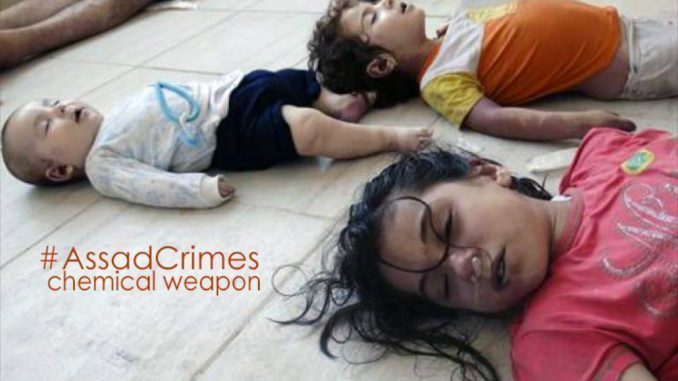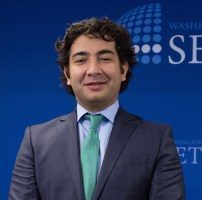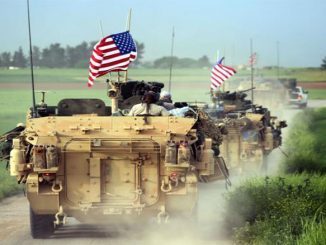
A UN investigative panel is pressing the Assad regime to hand over the names of commanders, military units and other entities suspected of carrying out chemical attacks in Syria, according to a report released Friday, AFP reported.
The long months of crippling siege on 275.000 civilians in eastern Aleppo, starvation policy, daily bombardment, fierce clashes and bloody massacres ended when the Assad regime and its allies were able to oblige the rebels in Aleppo to surrender and make an agreement to leave the area they have been holding since 2012 after losing more than 90% of it.
In a report on Monday, the US-based rights group said it had verified eight chemical attacks during the offensive from November 17 to December 13, adding that four children were among the victims.
HRW said it had interviewed witnesses, collected photos and reviewed video footage to reach the conclusion that chlorine bombs were dropped from government helicopters during the operation.
Around 200 people were wounded by the toxic gases used on opposition-controlled areas of the northern city, according to HRW.
One of the deadliest bombings hit the neighborhood of Sakhur on November 20, killing six members of the same family, including four children whose lifeless bodies were shown on a video taken by the Shabha press agency.
HRW said its report did not find proof of Russian involvement in the chemical attacks, but noted Moscow’s key role in helping the government to retake eastern Aleppo.
The HRW report detailed attacks on a playground, clinics, residential streets and houses that left scores of people struggling to breathe, vomiting and unconscious.
The alleged attacks, which may have involved as many as three helicopters operating jointly, took place in areas where government forces were poised to advance, said the rights group.
“The pattern of the chlorine attacks shows that they were coordinated with the overall military strategy for retaking Aleppo, not the work of a few rogue elements,” said Ole Solvang, HRW’s deputy emergencies director.
#Chlorine gas barrel bombs, seems it has become usual weapon regime is using day to day,in the besieged #Aleppo. pic.twitter.com/XXLLPFM6GU
— Zouhir_AlShimale (@ZouhirAlShimale) November 22, 2016
More details and information wanted
In its latest report to the Security Council, the joint panel of the United Nations and Organization for the Prohibition of Chemical Weapons (OPCW) said it had formally asked Syria to provide details of air operations, specifically at two air bases from which helicopters carrying the chlorine bombs lifted off.
Investigators are seeking the “names of specific Syrian Arab Armed Forces units and any entity outside the Armed Forces” listed on flight plans, said the report by the UN-OPCW Joint Investigative Mechanism (JIM).
“Such information is of great importance, given that commanders are responsible for any assets under their control,” said the report.
The panel said it was awaiting further determinations from the OPCW, which carries out fact-finding missions to establish whether chemical attacks took place, but does not attribute blame.
Human Rights Watch this week said it had collected witness accounts, photographs and video of at least eight chemical attacks carried out by the Assad regime in the final weeks of the battle for Aleppo late last year.
Can this report change anything?
HRW urged the UN Security Council to impose sanctions on senior leaders in the chain of Syrian command, but such a move would likely be vetoed by Russia.
There were also suggestions that France and Britain are pushing the Security Council to ban the sale of helicopters to Syria and impose the first UN sanctions against Syrian military leaders and entities tied to chemical weapons development.
A joint investigation by the UN and the Organization for the Prohibition of Chemical Weapons found that several units of the Syrian army had used toxic weapons against three villages in northern Syria in 2014 and 2015.
It was the first time an international probe blamed Assad’s forces after years of denial from his government in Damascus.
However, as the Syrians waited for the global powers to make real moves for protecting them, all they got were statements.
The US ambassador to the UN, Samantha Power, have previously said the use of chemical weapons was “barbaric” and called for “all states to support strong and swift action”.
Ms Power accused the Assad regime of violating a September 2013 resolution which orders the UN Security Council (UNSC) to impose measures for “any use of chemical weapons by anyone in the Syrian Arab Republic”.
Ned Price, a spokesman for the US National Security Council, said it was now “impossible to deny” the Syrian regime used weapons in violation of international law.
“The United States will work with our international partners to seek accountability through appropriate diplomatic mechanisms,” he said, adding that Russia and Iran should participate with UN member states.
French ambassador to the UN Alexis Lamek also said: “the council will have to act”.
“When it comes to proliferation, use of chemical weapons, such weapons of mass destruction, we cannot afford to be weak,” he added.
However, their statements were not translated into actions on the ground.
President Barack Obama said the use of chemical weapons in Syria was a “red line” for him but then withered when Assad’s forces used sarin-filled shells to kill some 1,400 Syrians men, women, and children in 2013. America has armed and trained Syrian rebels, but only in small numbers. It never bombed Assad’s forces their behalf or established a no-fly zone where Syrian civilians might be safe from Syrian and Russian airstrikes.
The Syrian crisis began as a peaceful demonstration against the injustice in Syria. Assad regime used to fire power and violence against the civilians and led to armed resistance. 450.000 Syrians lost their lives in the past five years according to UN estimates, and more than 12 million have lost their homes.



